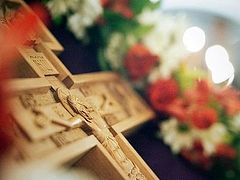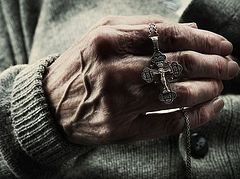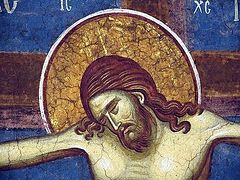Faithful, let us cry aloud with joy
as we greet the Cross of the Lord.
Let us sing triumphantly to God,
for it is a fountain of holiness to all in the world!
(Hymn for the Lenten Sunday of the Cross)
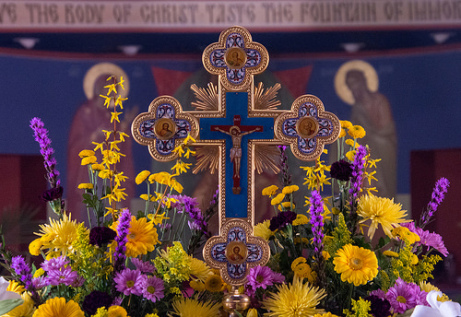
In his book, THE THEOLOGY OF JEWISH CHRISTIANITY, Jean Danielou points out that in the literary works from the first two Centuries of Christianity which focus on “the Cross as a theological symbol” the Cross is portrayed “as the power of Christ in his resurrection, as a sign of the cosmic scope of the redemption, and as an object of eschatological expectation” (Danielou, p 265). This focus will change over time and as monasticism gains dominance as being “normative” Christianity the Cross becomes more focused on the passion of Christ and on asceticism as a response to Christ’s passion. The more ancient focus in the literature “… is, however, obviously not the Cross as an image of Christ suffering, but the glorious Cross which will precede him at the Parousia. The modification of its significance in the former sense was brought about by later Christian asceticism, which saw in it not a prophecy of the Parousia, but a memorial of the Passion” (Danielou, p 269).
Monastic asceticism turned the focus away from the Parousia to the Passion of Christ. But then the humanism which followed in European Christianity turned the focus ever more on the human suffering of Christ. In Orthodoxy this tended to manifest itself by focusing on Mary’s own lamentations about the suffering of her son, while the West developed not only Mary’s suffering but also the human agony of Christ Himself as he is tortured and dies on the cross. I find it interesting that in the Canon for the Lenten Sunday of the Cross (the midpoint of Great Lent), we see that focus on the glorious and life-giving Cross far more than on the passion of Christ or on asceticism or fasting. The Cross thus is not so much a symbol of Christ’s death as it is a sign of His triumph over death. The Lenten Sunday of the Cross appears to be more in line with the earlier Christian emphasis.
In the Canon for the Sunday of the Cross we see what Danielou describes in his book as the focus of early Christianity:
“The Cross has thus been promoted to represent the whole plan of redemption. It reaches out to the whole of Creation; it symbolizes the action of the Word as well in the farthest heaven as in the abysses of hell, and represents the spread of this action over the breadth of space and the length of time.” (Danielou, pp 291-291)
The Cross represents Christ’s cosmic victory over all evil whether in the air, on earth or in hell. It is the sign of God’s triumph in which heaven and earth are full of God’s glory.
We also see the Cross as a sign of victory when the hymns of the Canon make reference to the Old Testament: Moses prefigures the Cross with outstretched arms in defeating Amalek, Moses prefigures the Cross in dividing the sea with his rod and then causing the sea to close on the Egyptians, Daniel stretches out his hands cross-like in the lion’s den, the wood is thrown into the bitter waters to make them sweet and drinkable, Jonah arose on the 3rd day from the whale. The Old Testament thus anticipates the Cross of the Lord, making it possible for us now to see God’s victorious triumph over death through Christ’s death on the cross.
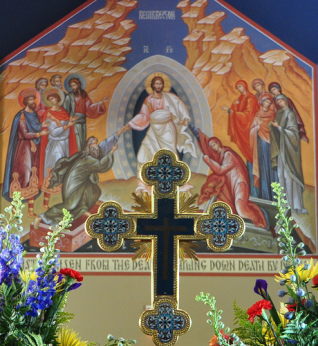
On the Lenten Sunday of the Cross, the canon also contains all the same Irmos hymns that we sing in the Canon for Paschal Matins. We begin the Matins Canon for the Cross with:
THIS IS THE DAY OF RESURRECTION:
LET US BE ILLUMINED, O PEOPLE!
PASCHA, THE PASCHA OF THE LORD!
FOR FROM DEATH TO LIFE, AND FROM EARTH TO HEAVEN
HAS CHRIST OUR GOD LED US,
AS WE SING THE SONG OF VICTORY!
We are already proclaiming the resurrection. The Cross is a festal sign, it celebrates the victory of Christ over sin, death, demons and Satan. The theme of the Sunday is not “Lent is long and hard and we have a lot more fasting yet to go.” Rather the theme is resurrection and we already know the destination because it is the basis for our daily life in Christ! The following are all hymns from the Canon for the Lenten Sunday of the Cross to give us some of the themes emphasized for this mid-Lent Sunday:
Today there is joy in earth and heaven,
for the sign of the Cross is made manifest to all the world!
The thrice‑blessed Cross is set before us;
a fountain of ever‑flowing grace to all who show it honor!
You arose on the third day from the tomb,
as one waking from sleep, O Lord.
By Your divine power, You struck down the keepers of hell,
raising up all our ancestors from the beginning of time,
for You alone are blessed and greatly glorified:
the God of our Fathers!
On this day, the Cross of Christ, the Wood anointed with life,
fills all things with the fragrance of divine grace.
As we smell its God‑given scent,
let us venerate it with faith forever!
Your tomb, O Christ, has brought life to me,
for You, the Lord of Life,
came and cried to those dwelling in the grave:
Be free, all who are in bonds,
for I am come, the Ransom of the world!
The Lenten Sunday of the Cross is not focused on the passion of Christ and His suffering on the Cross. Rather, it focuses on the Resurrection of Christ, the Holy Pascha which we will celebrate in another month. And by anticipation it looks forward to eschaton, when Christ will fill all things with Himself and death will be no more. The Cross is the sign of Christ’s victory, and from the beginning of Christianity it was celebrated as such.

